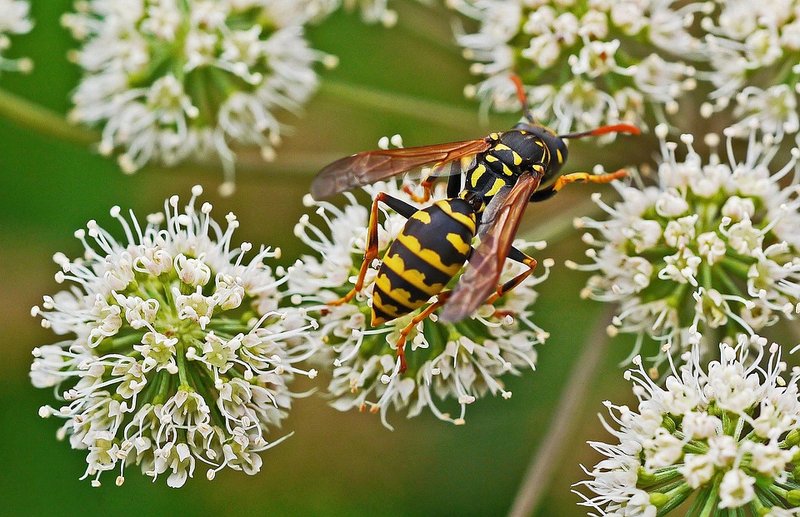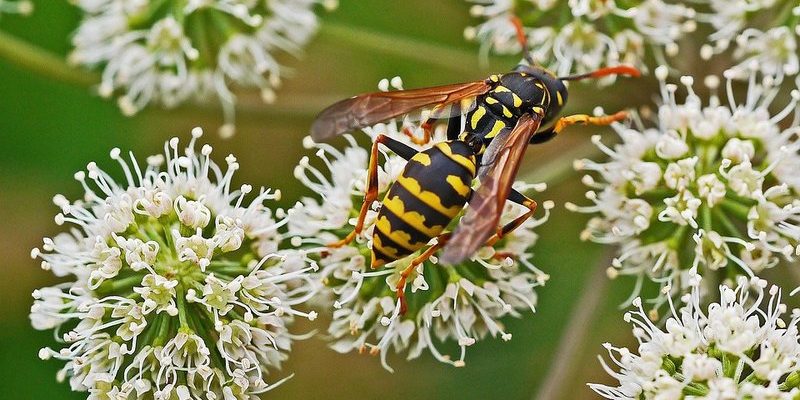
Picture this: you’re relaxing in your backyard on a sunny afternoon, and suddenly, a buzzing sound catches your attention. You look up to see a small, slender insect darting around. It’s a wasp! Wasps are often misunderstood creatures, frequently confused with bees, and they play vital roles in our ecosystem. But what exactly are they, and why should you care? Let’s dive into the world of these fascinating insects.
Wasps belong to the order Hymenoptera, which also includes bees and ants. There are over 30,000 species of wasps worldwide, ranging from the small, harmless varieties to the notorious yellow jackets known for their aggressive behavior. You might be surprised to learn that most wasps are actually solitary creatures, unlike the social bees we often think of.
In this article, we’ll cover everything from their biology and behavior to their role in nature and how to safely coexist with them. So grab a cup of coffee, and let’s get to know these intriguing insects a little better!
What Are Wasps?
Wasps are insects characterized by their slender bodies, two pairs of wings, and a narrow waist. Unlike bees, they usually have a shiny appearance due to their smooth exoskeletons and lack of dense body hair. This sleek look makes them more aerodynamic and agile flyers, an important trait when hunting for prey or evading threats. Wasps can be divided into two main groups: social and solitary. Social wasps, like yellow jackets and hornets, live in colonies and build nests, while solitary wasps prefer to live and hunt alone.
One of the most remarkable features of wasps is their diet. While bees primarily feed on nectar and pollen, most wasps are carnivores or omnivores. They play an essential role in controlling pest populations by hunting caterpillars and other insects. So, in a way, they act as nature’s pest controllers, helping keep our gardens and ecosystems balanced.
Interestingly, wasps also exhibit a range of colors and patterns. Some are brightly colored to warn predators of their sting, while others use camouflage to blend into their surroundings. Their adaptive coloration contributes to their survival, making them both beautiful and intriguing.
Wasp Anatomy
The anatomy of a wasp is quite fascinating, consisting of several key parts that serve specific purposes. Their bodies are divided into three main sections: the head, the thorax, and the abdomen. The head houses their large compound eyes, which allow for excellent vision and the ability to detect movement. Their antennae, which are often long and segmented, help with smell and taste, guiding them to food sources.
The thorax contains their powerful muscles, enabling them to fly efficiently. Wasps have two pairs of wings: the larger forewings and the smaller hind wings. These wings work together to provide the agility and speed wasps are known for, allowing them to zip around in search of food or evade predators.
To top it off, their stingers are modified ovipositors, used mainly for hunting and defense. When threatened, a wasp can sting multiple times, injecting venom that can cause pain and irritation. This defense mechanism is vital for their survival in the wild.
Wasp Behavior and Social Structure
When it comes to behavior, wasps can be quite complex. Social wasps are known for their structured colonies, which can contain hundreds to thousands of individuals. Each colony has a hierarchical system, including a queen, workers, and drones. The queen’s primary role is reproduction, while the workers gather food, maintain the nest, and care for the young. The drones, on the other hand, are male wasps whose sole purpose is to mate with the queen.
Solitary wasps live entirely different lives. They don’t form colonies and are completely independent. These wasps typically hunt for food, build nests, and lay eggs all alone. Some solitary wasps are even known to paralyze their prey and store them in nests for their larvae to feed on later. It’s almost like a horror movie plot, but it’s just nature being nature!
Wasps are also known for their communication skills. They use pheromones to signal danger or mark food sources. When a wasp finds food, it can leave a scent trail for other wasps to follow. This teamwork is essential for the survival of social colonies, showcasing their ability to work together for a common goal.
Ecological Importance of Wasps
Wasps might have a fearsome reputation, but they play an essential role in our ecosystem. As predators, they help control the population of pest insects, which can damage crops and spread diseases. By keeping these pests in check, wasps contribute to a healthy environment and agricultural success. Without them, we’d be facing a lot more bugs than we’d like!
In addition to being beneficial predators, wasps are also crucial for pollination. While they may not be as effective as bees, many wasp species do visit flowers to feed on nectar. While doing this, they transfer pollen from one bloom to another, aiding in plant reproduction. This connection highlights the interconnectedness of ecosystems—every creature, big or small, has its place and purpose.
Wasps can also be indicators of environmental health. A diverse wasp population in an area often means that the ecosystem is thriving. Conversely, a decline in wasp numbers can signal ecological issues. Thus, protecting wasps can help keep our environment balanced and flourishing.
Coexisting with Wasps
Now, you might be thinking about how to coexist with these buzzing insects without getting stung. The good news is that most wasps are not aggressive and won’t sting unless threatened. Here are some tips for living in harmony with them:
- Stay calm: If a wasp lands on you, try not to swat at it. Making sudden movements can trigger a defensive response.
- Avoid strong scents: Fragrances, perfumes, and sugary foods can attract wasps, so be mindful of what you have outside.
- Seal food and waste: Keep outdoor dining areas clean and cover food to reduce attraction. Ensure garbage cans have tight lids.
- Know their nesting habits: If you see a wasp nest, it’s best to contact a professional for removal, especially if it’s near high-traffic areas.
With these simple steps, you can enjoy your outdoor spaces while allowing wasps to fulfill their role in nature. Remember, they’re just doing their job— and often, they don’t want to bother you.
Wasp Myths and Misunderstandings
As with many creatures, wasps come with a bundle of myths and misunderstandings. One common myth is that all wasps are aggressive. While certain species can be territorial, many are actually quite docile. They prefer to keep to themselves, focusing on their daily tasks rather than bothering humans.
Another misconception is that wasps are useless pests. This couldn’t be further from the truth! As we’ve discussed, they play vital roles as predators and pollinators. They help maintain the balance in ecosystems and contribute to agricultural health.
People often believe that killing wasps will solve the problem of them buzzing around. However, this can actually make things worse, as it can release pheromones that attract more wasps. It’s essential to approach wasp encounters with understanding rather than fear.
Interesting Facts About Wasps
| Fact | Details |
| Species Diversity | There are over 30,000 species of wasps worldwide. |
| Diet | Most wasps are carnivorous, preying on insects and spiders. |
| Colony Size | A social wasp colony can have hundreds to thousands of individuals. |
| Stinging | Wasps can sting multiple times, unlike bees that lose their stinger after one use. |
| Pollination | While not as effective as bees, many wasps do contribute to pollination. |
| Life Span | Worker wasps typically live for a few weeks, while queens can survive for several years. |
Wasps may seem intimidating, but they greatly contribute to our ecosystem and agricultural health. Understanding their behavior and role helps demystify these insects, allowing us to coexist peacefully. When you spot a wasp buzzing by, remember they’re more than just a nuisance. They’re fascinating, complex creatures that play essential roles in our environment. So next time you see one, take a moment to appreciate the part they play in keeping nature in balance—after all, every little insect counts.
FAQ
Are wasps aggressive?
Wasps can be perceived as aggressive, especially when their nests are disturbed. However, most wasps are not naturally aggressive and will only sting if threatened. It’s essential to remain calm and avoid sudden movements around them. They generally prefer to focus on hunting and gathering food.
What do wasps eat?
Most wasps are carnivorous, feeding on other insects, spiders, and even nectar from flowers. They play a vital role in controlling pest populations. Some species can also consume ripe fruits and sugary substances, making them more active during late summer and fall when food is abundant.
How long do wasps live?
The lifespan of a wasp varies by species and role. Worker wasps live for a few weeks, while queens can survive for several years. After mating in the fall, queens will hibernate, and new colonies will be started in the spring by these queens.
How can I prevent wasps from nesting in my yard?
To deter wasps from nesting in your yard, ensure that trash cans are tightly sealed and clean up food spills promptly. You can also hang decoy nests, as wasps are territorial and will avoid areas where they think other wasps are present.
What should I do if I’m stung by a wasp?
If you get stung by a wasp, remain calm. Remove the stinger if it’s still in your skin. Clean the area with soap and water, then apply ice to reduce swelling. Over-the-counter pain relievers can help alleviate discomfort. If you experience severe reactions like difficulty breathing or swelling, seek medical attention immediately.
Do wasps die in the winter?
Most wasps do not survive the winter. Worker wasps die off as the weather cools, while mated queens find shelter to hibernate until spring. They are the only ones to survive the winter and will start new colonies once the temperatures rise.
Are wasps good for the environment?
Absolutely! Wasps help control pest populations, making them beneficial for gardens and farms. They also contribute to pollination, promoting plant reproduction. Their role in the ecosystem showcases the importance of every creature, big or small.
How can I safely remove a wasp nest?
Removing a wasp nest can be dangerous and is best left to professionals. If you must do it yourself, wear protective clothing and spray the nest at dusk when wasps are less active. Always prepare an escape route in case the wasps become aggressive.
Can wasps really remember faces?
Yes, research suggests that certain wasps can recognize and remember human faces. They use a combination of color and patterns to identify individuals, which helps them navigate their environment and avoid potential threats.
Why do wasps buzz?
The buzzing sound you hear from wasps is primarily due to their wings beating rapidly as they fly. This sound can vary depending on the species and size of the wasp. The buzzing may also serve as a warning to potential threats nearby.
Can wasps be beneficial to humans?
Definitely! Wasps can help reduce crop damage by preying on pest insects, which is beneficial for agriculture. They also aid in pollination, contributing to food production. By understanding and tolerating wasps, we can harness their natural benefits.
What time of year are wasps most active?
Wasps are most active in late summer and early fall. During this time, food becomes scarce, and their foraging behavior increases as they search for sugary foods. This is also when they become more noticeable around outdoor gatherings.

